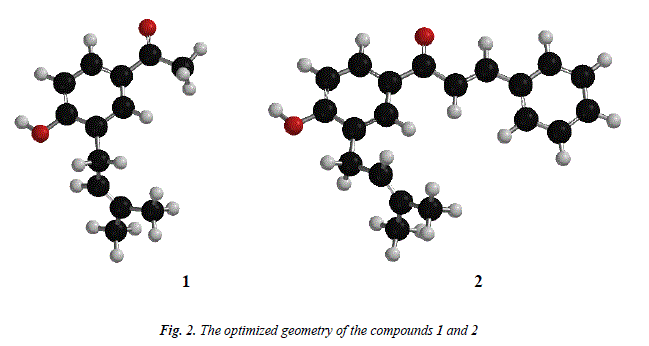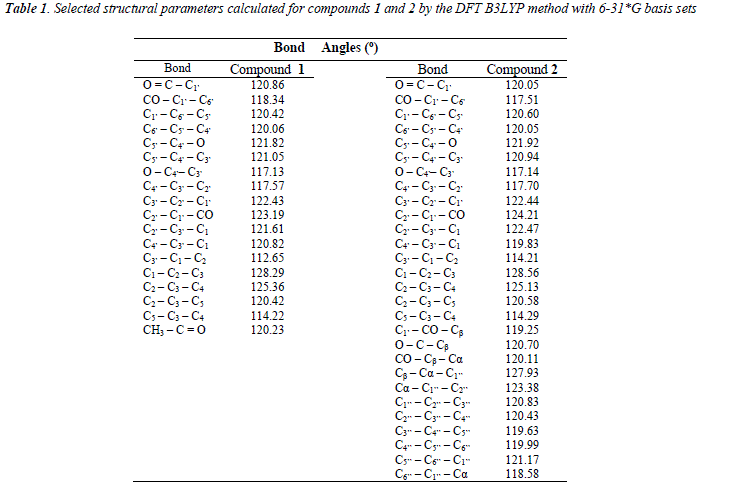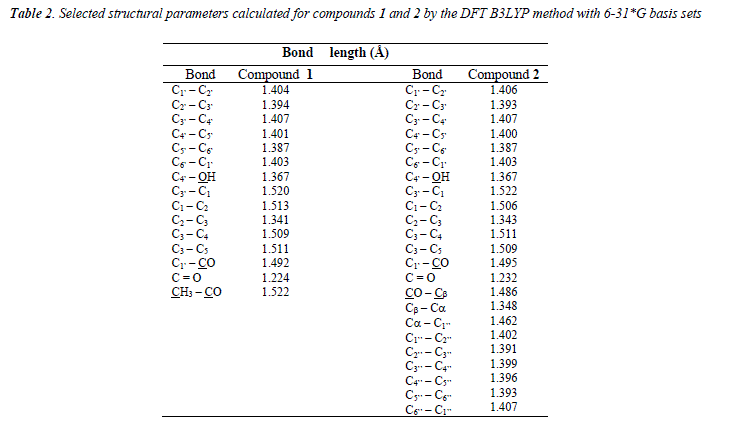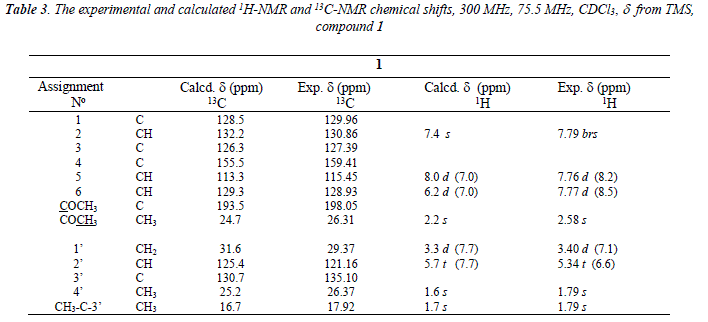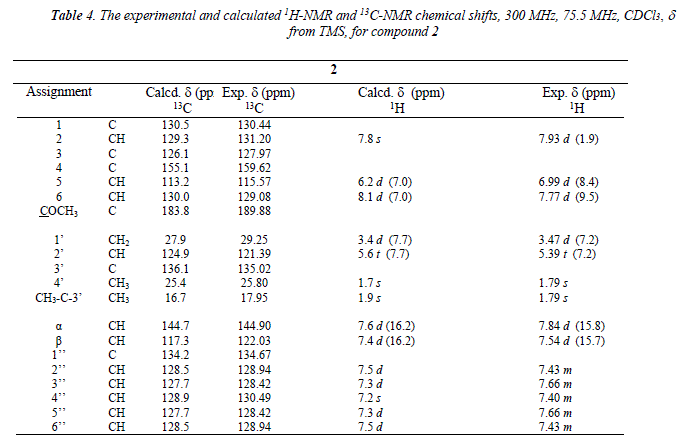Servicios Personalizados
Revista
Articulo
Indicadores
Links relacionados
Compartir
Revista Boliviana de Química
versión On-line ISSN 0250-5460
Rev. Bol. Quim vol.36 no.3 La Paz ago. 2019
FULL ORIGINAL ARTICLE
Density functional theory:computer-assisted study of 1H and 13C NMR spectra of 4-Hydroxy-3-(3'-methyl-2'-butenyl)
Acetophenone isolated from Senecio Graveolens and its microwave-assisted synthetic derívate,
4'-Hydroxy-3'-(3-Methyl-2-Butenyl) chalcone
Teoría funcional de la densidad: estudio asistido por computadora de los espectros de RMN 1H y 13C del
4-hidroxi-3-(3'-metil-2'-butenil) acetofenona aislada de Senecio Graveolens y su derivado sintetizado
por microondas, 4'-hidroxi-3'-(3-metil-2-butenil) chalcona
José A. Bravo 1, José L. Vila 2,*
1 Natural Product Laboratory, Phytochemistry, Chemical Sciences Department, Chemical Sciences Institute, IIQ, School of Pure and
Natural Sciences FCPN, Universidad Mayor de San Andres UMSA, P.O. Box 303, Calle Andrés Bello s/n, Ciudad Universitaria
Cota Cota, phone +59122792238, La Paz, Bolivia, jabravo@umsa.bo, joseabravo@outlook.com, www.umsa.bo
2 Natural Product Laboratory, Green Chemistry, Chemical Sciences Department, Chemical Sciences Institute, IIQ, School of Puré and
Natural Sciences FCPN, Universidad Mayor de San Andres UMSA, P.O. Box 303, Calle Andrés Bello s/n, Ciudad
Universitaria Cota Cota, phone +59122772269, La Paz, Bolivia, jlvila@umsa.bo, www.umsa.bo
* Corresponding author:joselu62@hotmail.com
Received: 05/14/2019 Accepted: 08/15/2019 Published: 08/30/2019
Abstract
The spectral computer-assisted study of 1H and 13C NMR chemical shifts (8), and some other molecular properties of 4-hydroxy-3-(3-methyl-2-butenyl)acetophenone 1 and 4'-hydroxy-3'-(3-methyl-2-butenyl)chalcone 2 was carried out by using the density functional theory. Compound 1 was isolated from Senecio graveolens and its synthetic derivative 2 obtained by microwave irradiation of 1 with benzaldehyde, as previously published by the authors. The calculations yielded reliable results that are in good correlation with the corresponding experimental data. This is a good basis for collaboration between experimental and quantum chemists. Following current trends in NMR data description for small molecules, for its human- and computer-accessible 2D correlation data computer reading and storing, we summarized the ID and 2D NMR experimental data of 1 and 2.
Keywords: NMR spectra, Spartan 19 software, Quantum chemistry, Chemical shifts.
Resumen
Utilizando la teoría funcional de la densidad, se realizó el estudio espectral asistido por computadora de los desplazamientos (8) químicos de RMN lH y 13C, y de algunas otras propiedades moleculares de la 4-hidroxi-3-(3-metil-2-butenil)acetofenona 1 y de la 4'-hidroxi-3'-(3-metil-2-butenil)chalcona 2. El compuesto 1 fue aislado en un trabajo previo de las partes áreas de Senecio graveolens y su derivado sintético 2 fue obtenido por irradiación con microondas de 1 con benzaldehído, tal como lo publicaron previamente los autores. Los cálculos arrojaron resultados confiables que están en buena correlación con los datos experimentales. Esta es una buena base para la colaboración entre químicos experimentales y cuánticos. Siguiendo las tendencias actuales en la descripción de datos de RMN para moléculas pequeñas, para su lectura y almacenamiento de datos de correlación 2D accesibles por computadora y humanos, resumimos los datos experimentales de RMN ID y 2D de 1 y 2.
Palabras clave: RMN espectros, Software Spartan 19, Química cuántica, Desplazamientos químicos.
INTRODUCTION
Density functional theory (DFT, density functional theory) are calculations ab initio and semiempirical, based on the Schrodinger equation, being one of the most popular and successful quantum mechanical approaches to matter [1]. Density functional theory (DFT) has become the dominant tool in chemistry and physics for calculations of electronic structure [2,3].
The present article is a supplementary subject in the structural study of natural compounds and their hemi-synthetic derivatives published before by the authors as for instance in the synthesis of the new 4'-hydroxy-3'-(3-methyl-2-butenyl)chalcone by microwave-assisted condensation of 4-hydroxy-3-(3'-methyl-2'-butenyl)acetophenone isolated from Senecio graveolens and benzaldehyde [4].
The natural compound 1, 4-Hydroxy-3-(3'-methyl-2'-butenyl)acetophenone isolated from Senecio graveolens [4] was studied with regard to the vibrational and electronic properties which were determined by combining experimental data and quantum calculations [5]. This structural study of 1, was based on normal analysis and vibrational spectra [6].
In recent years, DFT calculations have been used extensively for a wide variety of molecular properties, such as equilibrium structure, charge distribution, NMR spectra, providing thus reliable results that are in good correlation with experimental data [7,8].
We have taken an advantage of the :H and 13C NMR spectra of 1 and 2 previously acquired [4]. The geometry was optimized at the B3LYP level for 1 and 2, and used to perform theoretical calculations on the structures (Fig. 1).
Correlation coefficients were used to compare the experimentally observed change and that calculated theoretically for the natural compound and its synthetic derivative.
RESULTS AND DISCUSSION
Theoretical calculations
Calculations were done using the Spartan 18 software. This method was used for calculating 1H-NMR and 13C-NMR chemical shifts at the B3LYP/6-31*G level for 1 and 2.
The optimized structural parameters, bond lengths and bond angles for the thermodynamically preferred geometry of compounds 1 and 2 (that were determined at the B3LYP/6-3P*G level) are exposed in Tables 1 and 2 showing bond lengths C-C, C-H and C-0 calculated, in accordance with the atom numbering of Fig. 1 and the 3D structures of Fig. 2,
Bond Angles
The bond angles calculated are very similar to each other in these molecules. An investigation of the bond angles O=C-C1', C2-C1-CO, CO-C1 -C6, C1-CO-Cβ, O-C-Cβ and CO-Cβ-Cα showed that these atoms possess a hybrid configuration sp2 trigonal planar.
Bond Lengths
From the structural data, it was observed that the C-C and C-0 bond distances calculated are found to be nearly the same for both, 1 and 2. The influence of the substituent on the molecular parameters, particularly the bond distance of CH3-CO of 1 and CO-Cβ of 2, seem to be negligibly small.
Comparison of the experimentally measured and theoretically computed chemical shifts
Chemical shifts calculated using the B3LYP level with the 6-31*G basis sets can be utilized to eliminate the uncertainties in the fundamental assignments of 1 and 2.
Comparison of experimental signals of 1H-NMR and 13C-NMR (in ppm) with computed values of compounds 1 and 2 are shown in Tables 3 and 4. From the perusal of these tables it is concluded that there is a good correlation ship between the experimental and theoretical chemical shifts, being therefore an excellent predictive ability of the method applied in the case of compounds 1 and 2.
EXPERIMENTAL
Plant material
The plant material description can be found in the experimental section of the previously published work by the authors [4]. For making easier access to such information, we reproduced it entirely here with permission given by Rev. Bol. Quim. The species Senecio graveolens (Asteraceae) was collected in the municipal county of Tinquipaya, Tomás Frías province, Department of Potosí; GPS coordinates: 19°13'6" SW (southwest) y 65°49'35" W (west), a 3,800 m.a.s.l. in September 2016. Characteristic climate: cold (2 °C to 12 °C). The plant was taxonomically identified at the National Herbarium of Bolivia (LPB). A specimen voucher is deposited at LPB under the code YQC-1.
Isolation of compound 1
Similarly, to the plant material description, the isolation procedure of 1 can be found in the previous work by the authors [4]. We reproduced it here for access reasons with permission given by Rev. Bol. Quim. The leaves of the vegetal sample were dried at room temperature and were ground to afford a final weight of 15000g (15kg). This mass was entirely treated with a two-step process of solid-liquid extraction with 30 L of ethanol (96°) in 5 containers of 10L each for 14 days each step. Filtiation and solvent evaporation (56°C) of the first ethanol extraction was done at reduced pressure until reaching 10% of the original volume of EtOH solution (3 L). No dry extract was obtained. No precipitate like crystals were noticed during the concentration of the first ethanol extract. The first extract was kept indefinitely in refrigerator at 4°C for further treatment. No weighing was done with the vegetal material after the first extraction and corresponding drying. Thus, the same original mass of vegetal material (after the first extraction) was extracted with EtOH 96° for the second time under the same conditions as the first one. During concentration (56°C) at reduced pressure orange-like colored crystals appeared quantitatively. In this later process the solvent volume was reduced approximately until the 10% of its original amount. Crystals were filtered from the solution (4.9 g, 0.03% of original sample). Silica-gel TLC assays were run in EtOAc/EtOH 1:1 at prudential stages of the process showing the presence of a major spot corresponding to compound 1 as the major constituent of the EtOH-2 extract. 4.9 g of 1 were submitted to re-crystallization for 24 hrs in cold EtOH (0°C) twice. After each 24 hrs crystals were filtered and washed with cold EtOH (0°C) in a Büchner funnel. The TLC assay (EtOAc/EtOH 1:1) over the re-crystallized 1 showed still impurity. A semi-micro silica gel (0.98 g) liquid chromatography in a Pasteur pipette was performed with 1, EtOAc was used to dissolve the sample before separation in column. The first 24 fractions (5 mL each) extracted from column were eluted with of EtOAc giving rise to an orange-like colored pure compound according to TLC assay (EtOAc) corresponding to compound 1. This was recrystallized in CH2Cl2. Other 23 fractions (5 mL each) were extracted from column by solvent EtOH giving rise to a second black compound according to TLC analysis (EtOAc/EtOH 1:1).
Microwave-assisted condensation synthesis of compound 2
This experiment was performed when obtaining compound 2 as described by the authors in a previous paper [4], we reproduced it here with permission given by Rev. Bol. Quim. for easier access for the reader. NaOH (10% [0.2 g/2mL]) with EtOH 95% (2mL) and compound 1 (crystals, 488 mg) were stirred in heating plate at 35 °C in a 50 mL flask. Once the crystals of 1 dissolved, benzaldehyde (2.5 mL) was added to the reaction mixture. Mixture was irradiated under microwave conditions (170 Watts) four times during 10 min each with cooling intervals of 10 s. Water (25 mL) and AcOH (2.0 mL) were added to the reacting mixture. Two phases were formed after agitation and they were separated in a separation funnel. The organic layer was washed with distilled water thrice and separated in layers each time. The organic layer was put at 4°C in freezer overnight. A solid precipitate appeared in the bottom of the flask. Once separated by filtration it was washed with hexane and dichloromethane in a silica gel Pasteur pipette. Yellow crystals were obtained that weighed 525 mg. The reaction yield was calculated as 71%.
Physicochemical data of compounds 1 and 2 (originally from [4] with permission given by Rev. Bol. Quim.)
Compound 1: 4-Hydroxy-3-(3 '-methyl-2 '-butenyljacetophenone
MP: 94-95°C uncorrected; NMR; see Table 3.
Compound 2: 4 '-hydroxy-3 '-(3-methyl-2-butenyl) chalcone
MP: 106-107 °C uncorrected; NMR see Table 4; FTIR (solid): vmax [cm-1] 827 (ArC-H δ oop), 977 (ArC-H δ ip, δ oop), 1131 (ArC-H δ ip, C-0 st), [1250, 1283, 1334 (C-0 st)], 1564 (C=C st), 1648 (C=O st), [3243, 3463, 3629 (O-H st)]; UV (EtOH50ºc) γmax (log ε) nm: 263.0 (3.62) nm; ESI-MS/MS m/z 69, 131, 238, 294 [(M+H)+]; m/z 85, 151, 294 [(M+H)+], 316 [(M+H+Na)+], 332 [(M+H+K)+], 608 [(2M+H+Na)+].
Computational details
The DFT calculations were performed on an Intel (R), Pentium (R) Dual Core personal computer using the Spartan'18. Geometries of the compounds were first optimized at 6-311++G(d,p) basis set. Optimized structural parameters in gas phase were used in the vibrational frequency calculations at DFT level to confirm the structure as minima. Using Gauss View 4.1.2 molecular visualization program, the vibrational frequency assignments and other parameters were made. For NMR calculations, the calculated chemical shifts were obtained by GIAO method using the B3LYP/6- 31++G(d,p) level of theory using TMS as reference.
NMR measurements
All equipment belongs to Department of Chemical Sciences UMSA; NMR spectrometer: Bruker DRX300, (300 MHz, 75 MHz), TMS used as internal standard. The chemical shifts, ppm, are referred to TMS as an internal standard. The following measurement techniques were used: standard 1H-, attached proton test (APT), correlation spectroscopy (COSY), and heteronuclear múltiple quantum correlation (HMQC) and heteronuclear múltiple bond correlation (HMBC) spectroscopy.
Computer-readable graphical description of protón, carbón, COSY, HMQC and HMBC, for some simple coupling systems of compounds 1 and 2 [4,9]
Compound 1
NMR data of compound 1, HMBC correlations (excerptfrom [4] with permission given by Rev. Bol. Quim.)
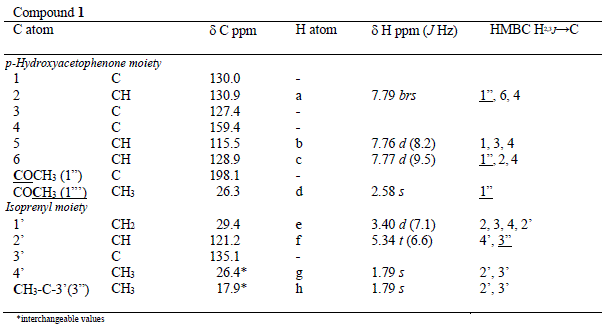
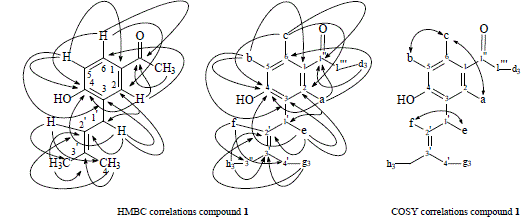

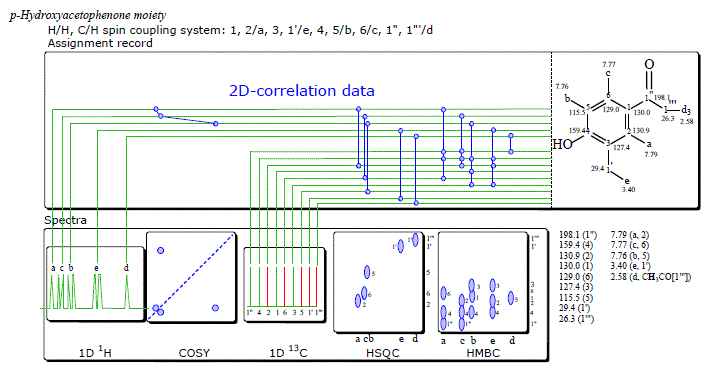
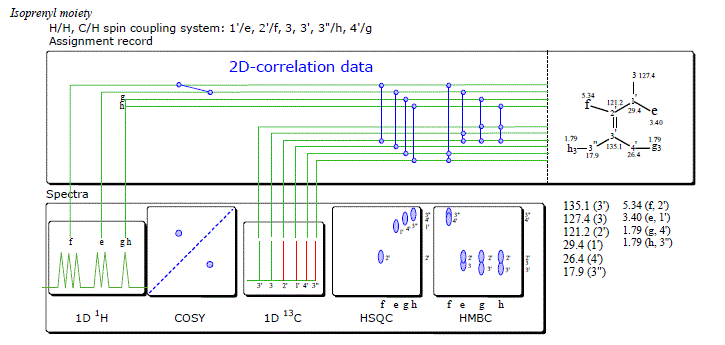
Compound 2
NMR data of compound 2, HMBC and HSQC spectra (excerpt from [4] with permission given by Rev. Bol. Quim.)
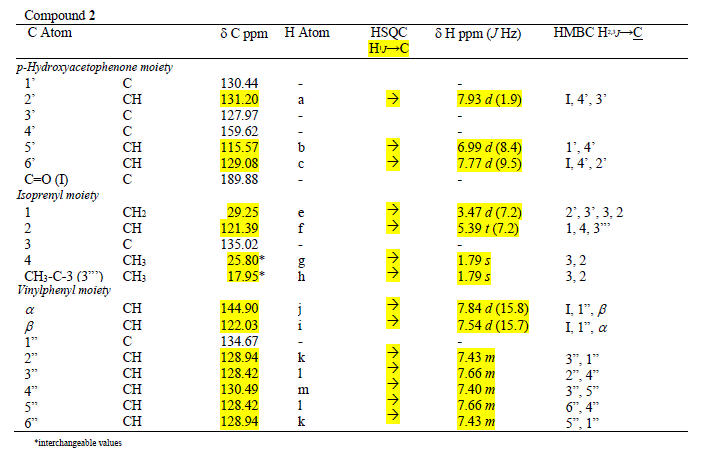

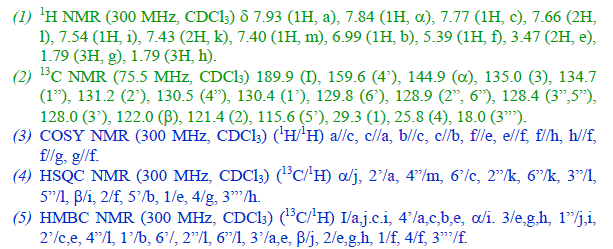
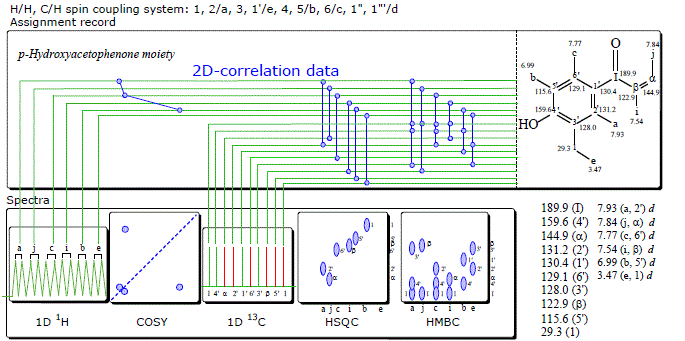
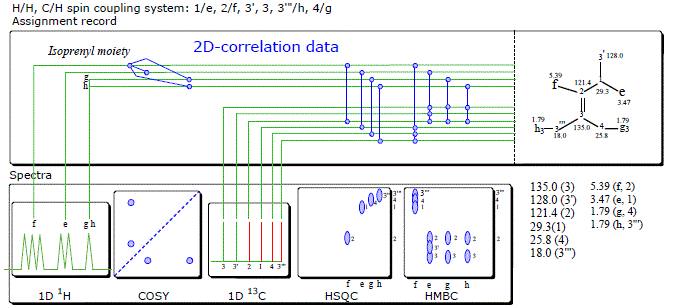
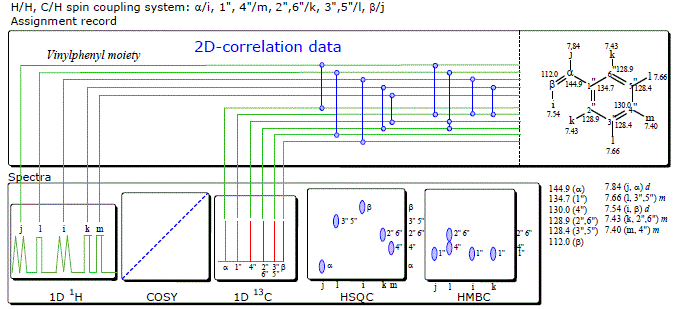
CONCLUSIONS
Selected structural parameters of the geometries of the 4-Hydroxy-3-(3'-methyl-2'-butenyl) acetophenone (1), a natural product isolated from Senecio graveolens, and its MW-obtained derívate, 4'-hydroxy-3'-(3-methyl-2-butenyl)chalcone (2) were obtained by DFT calculations. The optimized geometry was computed by DFT B3LYP/6-31*G methods using Spartan 18 software. 1H-NMR and 13C-NMR chemical shifts were calculated and the assignments were compared with the experimental valúes.
REFERENCES
1. Capelle, K. 2006, A bird's-eye view of density-functional theory, Brazilian Journal of Physics, 36(4A), 1318-1343. [ Links ]
2. Parr, R.G., Yang, W. Density-functional theory of atoms and molecules, Oxford University Press, 1989, New York, Oxford. [ Links ]
3. Dreizler, R.M., Gross, E.K.U. Density functional theory an approach to the quantum many-body problem, Springer, 1990, Berlin. [ Links ]
4. Ibieta Jiménez, G., Bravo, J.A., Quispe Coro, Y., Solís, O., Vila, J.L. 2017, Synthesis of the new 4'-hydroxy-3'-(3-methyl-2-butenyl)chalcone by microwave-assisted condensation of 4-hydroxy-3-(3'-methyl-2'-butenyl)acetophenone isolated from Senecio graveolens and benzaldehyde, Bolivian Journal of Chemistry, 34 (3), 89-103. [ Links ]
5. Gil, D.M., Lizarraga, E., Echeverría, G.A, Piro, O.E., Catalán, C.A.N., Altabef, A.B. 2017, A combined experimental and theoretical study of the supramolecular self-assembly of the natural benzopyran 2,2-dimethyl-3-hydroxy-6-acetyl-chromane and its isomeric benzofuran 10,11-dihydro-10-hydroxytremetone, Journal o/Molecular Structure, 1146, 164-178. [ Links ]
6. Lizarraga, E., Romano, E., Rudyk, R.A., Nazareno Catalán, C.A., Brandan, S.A. 2012, Structural study, coordinated normal analysis and vibrational spectra of 4-hydroxy-3-(3-methyl-2-butenyl)acetophenone, Spectrochimica Acta Part A: Molecular and Biomolecular Spectroscopy, 97, 202-208. [ Links ]
7. Koch, W., Holthausen, M.C. A Chemist's Guide to Density Functional Theory, Wiley-VCH Verlag GmbH, 2nd ed., 2001, Weinheim. [ Links ]
8. Spirtovic-halilovic, S., Salihovic, M., Trifunovic, S., Roca, S., Veljovicl, E., Osmanovic, A., Vinkovic, M., Zavrsnik, D. García-Molano, J.F., Carvajal-Rodríguez, D.C. 2014, Density functional theory: 1H- and 13C-NMR spectra of some coumarin derivatives, J. Serb. Chem. Soc, 79(11) 1405-1411. [ Links ]
9. Jeannerat, D. 2017, Human- and computer-accessible 2D correlation data for a more reliable structure determination of organic compounds. Future roles of researchers, software developers, spectrometer managers, journal editors, reviewers, publisher and database managers toward artificial-intelligence analysis of NMR spectra, Magn. Reson. Chem., 55, 7-14. [ Links ]












 uBio
uBio 

